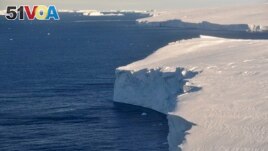09 January 2022
Researchers are sailing to a distant part of Antarctica so they can better understand how much and how fast seas could rise because of global warming. The area, which is where the Thwaites glacier is located, is sometimes called "the place in the world that's the hardest to get to."
Thirty-two scientists are starting a more than two-month trip aboard an American research ship. Their goal is to study the area where the large, but melting, Thwaites glacier faces the Amundsen Sea.
The glacier, which is about the size of the American state of Florida, has gotten the nickname the "doomsday glacier." The nickname comes from how much ice it has and how much seas could rise if it all melts — more than 65 centimeters over hundreds of years.

This 2020 photo provided by the British Antarctic Survey shows the Thwaites glacier in Antarctica. (David Vaughan/British Antarctic Survey via AP)
Because of its importance, the United States and the United Kingdom launched a $50 million mission to study Thwaites, the widest glacier in the world. Not near any of Antarctica's research stations, Thwaites is on Antarctica's western half, east of the Antarctic Peninsula.
Anna Wahlin of the University of Gothenburg in Sweden is on the research trip. In a discussion while aboard the Research Vessel Nathaniel B. Palmer, Wahlin said "Thwaites is the main reason I would say that we have so large an uncertainty in the projections of future sea level rise."
She added, the area was "difficult to reach."
Thwaites is putting about 50 billion tons of ice into the water a year. The British Antarctic Survey says the glacier is responsible for 4 percent of global sea rise.
University of Colorado ice scientist Ted Scambos said from the McMurdo land station last month that the conditions driving Thwaites' ice loss are increasing.
No one has stepped foot before on the key ice-water meeting point at Thwaites. In 2019, Wahlin was on a team that explored the area using a robotic ship, but never went on it.
Wahlin's team will use two robot ships, her own large one called Ran which she used in 2019, and Boaty McBoatface, the drone that could go further under the area of Thwaites.
The scientists will be measuring water temperature, the sea floor and ice thickness. They will look at cracks in the ice and how the ice is structured. They will also study seals on islands off the glacier.
Thwaites "looks different from other ice shelves," Wahlin said. "It almost looks like a jumble of icebergs that have been pressed together. So, it's increasingly clear that this is not a solid piece of ice like the other ice shelves are."
I'm John Russell.
Seth Borenstein reported on this story for the Associated Press. John Russell adapted it for Learning English
_____
Words in This Story
glacier – n. a very large area of ice that moves slowly down a slope or valley or over a wide area of land
nickname – n. a name that is different from your real name but is what your family, friends, etc., call you when they are talking to you or about you
doomsday – n. the day the world ends or is destroyed
projection – n. an estimate of what might happen in the future based on what is happening now
shelf – n. a flat area of rock, sand, etc., especially underwater
jumble – n. a group of things that are not arranged in a neat or orderly way











